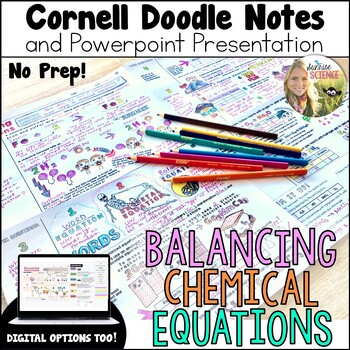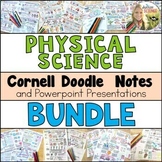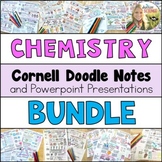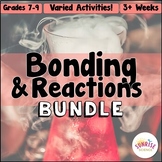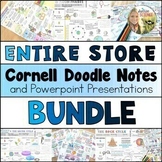Balancing Chemical Equations Doodle Notes | Middle School Science | Cornell Note
- PDF
- Internet Activities
What educators are saying
Also included in
- This is a growing bundle of all of my Physical Science Cornell Doodle Notes. This resource currently contains Cornell Doodle Notes and the associated Powerpoint / Google Slides Presentations for Physical Science 28 topics. The price at this point reflects only what is in the bundle at this time, pluPrice $103.00Original Price $144.12Save $41.12
- This is a growing bundle of all of my Cornell Doodle Notes on Chemistry topics. This resource currently contains Cornell Doodle Notes and the associated Powerpoint / Google Slides Presentations for 21 topics.✨ If you buy this bundle today, you are receiving 20% off on the current resources, plus youPrice $87.00Original Price $109.15Save $22.15
- Looking for fun and engaging ways to teach your students about chemical bonding and reactions?This bundle contains 17+ activities (including one *bonus* activity) and 5 assessments to help you teach and assess the following topics:Counting Atoms in Chemical FormulasValence Electrons/Lewis Dot DiagraPrice $50.00Original Price $67.90Save $17.90
- This is a bundle of all of my resources for teaching chemistry concepts at the 8th / 9th grade level, including laboratory equipment and safety, states, properties and changes in matter, atoms and the periodic table, and bonding and chemical reactions. These resources include a mix of Cornell DoodlePrice $195.00Original Price $252.47Save $57.47
- This is a bundle of all of my resources for teaching physical science at the middle school level! These resources include a mix of Cornell Doodle Notes, labs, demonstrations, inquiry activities, self-paced digital 5E lessons, manipulatives, projects, pixel art review activities, and assessments. IPrice $297.00Original Price $384.06Save $87.06
- This is a growing bundle of ALL of my Science Cornell Doodle Notes resources. This bundle currently contains Cornell Doodle Notes and the associated Powerpoint / Google Slides Presentations for 48 science topics. The price at this point reflects what is in the bundle at this time, plus 20% off. As aPrice $189.00Original Price $244.25Save $55.25
- This mini-bundle contains three sets of Cornell Doodle Notes for teaching or reviewing about Chemical Reactions! The topics included are: Endothermic and Exothermic Processes, Balancing Chemical Equations, and Types of Chemical Reactions. Get 20% off of these resources by purchasing them in this bunPrice $12.49Original Price $15.59Save $3.10
Description
These scaffolded Balancing Chemical Equations Cornell Doodle Notes combine two effective note-taking strategies and can be used to introduce, teach, or review the concept of balancing chemical equations and the Law of Conservation of Mass. These notes review chemical formulas including coefficients and subscripts, differentiate between word, skeletal, and balanced equations, use two non-chemistry analogies to help students visualize what a balanced equation means, give steps for balancing an equation, and include practice problems. Please note that these notes are meant to be an introduction to the process and they do not cover polyatomic ions. The level of these notes is perfect for middle school or as an introduction to balancing equations in high school.
The concepts here align with NGSS MS-PS1-5 (Develop and use a model to describe how the total number of atoms does not change in a chemical reaction and thus mass is conserved) and HS-PS1-7 (Use mathematical representations to support the claim that atoms, and therefore mass, are conserved during a chemical reaction). These notes also represent the crosscutting concepts of patterns, and energy and matter.
Cornell Notes are a note-taking strategy in which topic questions are written in a narrow left-hand column and definitions, explanations, and diagrams are filled in in the right-hand column.
Doodle Notes are another note-taking strategy for which pictures and graphics activate the visual pathways of the brain, which helps with retention of information when compared to standard note-taking. Your visual learners will really benefit from seeing and coloring in the pictures aside the main points of the notes!
What's Included (please see the preview also!):
- The Cornell Doodle Notes are 5-pages each and there are 2 scaffolded versions plus the answer key
- Two presentation options: Powerpoint AND Google Slides
- Google Slides digital version of the notes with student directions and Google Tools and Fonts sidebar
Here are some ways that I suggest using this resource:
✎ Whole-Group lesson with scaffolding : Decide which students should receive which level of the notes. Hand out the notes to the students. Use the Powerpoint or Google Slides as a presentation and talk aloud through the lesson while the students take notes OR If you have a document camera (an ELMO), you can fill out your own notes and the students can follow along with you as you discuss the concepts aloud! Stop throughout the lesson to have the students pair-share and discuss what they are learning. Allow them to color/doodle further during and at the end of the lesson.
✎ Scaffolded Small-Group lesson : Separate your students into groups by learning level. Give each student group sets of the appropriate notes for their level. Make sure each group has a device to view the presentation. Post the Powerpoint or Google Slides to your Google Classroom or other online learning platform, or email the Powerpoint version to one ‘student leader’ in each group. The students would view the Powerpoint/Slides together on one device and fill in the notes. Encourage them to add color/further notes.
✎ Individual Note-Taking or Flipped Classroom : Post the Powerpoint or Google Slides presentation to your Google Classroom or other online learning platform OR print out the slides and post them around your room -- give students a clipboard! Hand out the appropriate-level notes to each student. Students can work at their own pace to view the presentation and complete their notes. Encourage them to add color/further notes. Could also be assigned for homework or as a “half & half lab” for which one group of students is taking notes at their desks while another group is performing a lab.
✎ Distance Learning Scenario: Create a screencast lecture using one of the presentation options, or you could record audio clips over each slide that your students will play as they view the presentation.
Options for Digital Note-taking:
- Assign the Google Slides version of the notes (please view the Preview for images of what this version looks like!)
- Assign these notes digitally using the Kami Extension for Google Classroom. Learn about this option by downloading THIS FREEBIE!
Please note that this resource is not editable due to font and clip art licensing agreements and also to protect my work. However, you can always add additional text boxes to the presentation, as well as insert new slides with images/text/video clips, etc. to customize the lesson for you and your students!
Doodle notes is a trademarked term used with permission. Please visit doodlenotes.org for more information.
If you are teaching a unit on chemical reactions, you may also be interested in these resources:
Counting Atoms in Chemical Formulas Magic Pixel Picture Review
Chemical Reactions Cornell Doodle Notes and Powerpoint
Thanks for looking!
Sunrise Science

